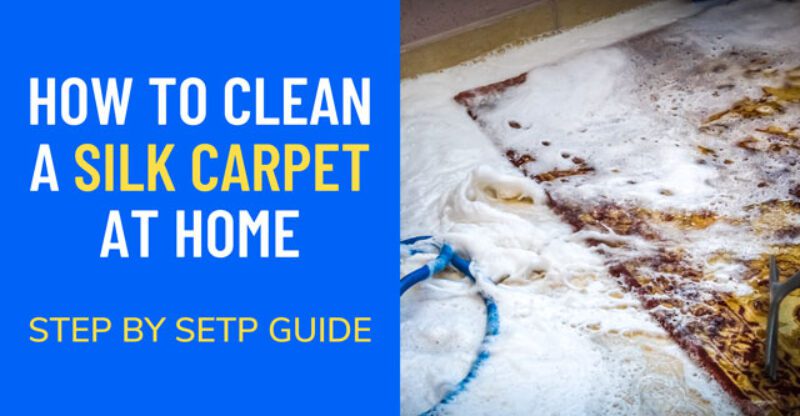How to Clean a Silk Carpet at Home: Step By Step Guide
Silk carpets are not only luxurious but also delicate. Cleaning them requires proper care and attention to maintain their beauty and longevity. If you own a silk carpet and want to learn how to clean it effectively at home, this article will guide you through the process.
Silk carpets add a touch of opulence to any room, but they can accumulate dust, dirt, and stains over time. Regular cleaning is essential to preserve their appearance and extend their lifespan.
Silk carpets are made from natural silk fibers, which are derived from the cocoons of silkworms. These carpets are delicate and sensitive to moisture, heat, and harsh chemicals. Silk carpets are often hand-woven and feature intricate patterns and designs, making them highly sought after.
We will discuss the necessary preparations to clean silk carpets at home, handle common carpet issues, and proper maintenance to look its best shape.
Importance of Proper Cleaning
Proper silk carpet cleaning is crucial to maintain its beauty and durability. Regular removal of dirt, dust, and stains not only enhances its visual appeal but also prevents the buildup of allergens and bacteria.
By following the right cleaning methods, you can ensure that your silk carpet remains fresh and vibrant for years to come.
Preparing for Cleaning
Before diving into the cleaning process, it’s important to gather the necessary tools and assess the condition of your silk carpet.
Here’s what you’ll need:
Gathering Necessary Tools and Supplies
To clean a silk carpet effectively, you will need the following tools and supplies:
- Soft-bristled vacuum cleaner attachment
- Clean, white microfiber cloths
- Mild detergent or specialized silk carpet cleaner
- Distilled water
- Spray bottle
- Clean sponge or soft brush
- Plastic sheet or tarp
- Fan or air blower (optional)
Assessing the Carpet’s Condition
Take a close look at your silk carpet and identify any visible stains, spills, or areas that require special attention. It’s important to note these areas before proceeding with the cleaning process to ensure they receive proper treatment.
Vacuuming the Silk Carpet
Vacuuming is an essential first step in cleaning a silk carpet. It helps remove loose dirt, dust, and debris that may be embedded in the carpet fibers.
Follow these steps for effective vacuuming:
- Use a soft-bristled vacuum cleaner attachment to avoid damaging delicate silk fibers.
- Gently vacuum the entire surface of the carpet, working toward the pile.
- Pay special attention to high-traffic areas and areas where dust and dirt tend to accumulate.
- For spills or stains, avoid using the vacuum cleaner directly and proceed to the next section on treating stains.
Treating Stains on a Silk Carpet
Stains on a silk carpet can be challenging to remove, but with the right techniques, you can minimize their appearance.
Here’s how to tackle stains effectively:
Identifying the Type of Stain
Different stains require different treatment methods. Identify the type of stain on your silk carpet to determine the best approach for removing it.
Common types of stains include:
- Food and beverage stains
- Oil-based stains
- Ink stains
- Pet stains
- Water-based stains
Using Gentle Stain Removal Techniques
For food and beverage stains, blot the stain gently with a clean, white microfiber cloth. Avoid rubbing the stain, as it may cause it to spread. If the stain persists, mix a mild detergent with distilled water in a spray bottle and lightly spray the affected area. Blot the stain with a clean cloth until it is removed.
For oil-based stains, sprinkle a small amount of cornstarch or talcum powder on the stain and let it sit for a few hours. The powder will absorb the oil. Gently brush off the powder and repeat the process if necessary.
Ink stains are best treated by blotting the stain with a cloth soaked in isopropyl alcohol. Be cautious not to oversaturate the carpet, as excessive moisture can damage silk fibers. Continue blotting until the ink stain is lifted.
For pet stains, gently blot the area with a cloth dampened with a mixture of mild detergent and distilled water. Avoid using ammonia-based cleaners, as they can damage silk fibers.
Water-based stains, such as coffee or tea spills, can be treated by blotting the stain with a cloth soaked in a mixture of distilled water and mild detergent. Blot the stain until it is removed.
Deep Cleaning the Silk Carpet
Once you have treated the stains, it’s time to proceed with deep cleaning the silk carpet. Follow these steps for a thorough cleaning:
Testing for Color Fastness
Before applying any cleaning solution to the entire carpet, it’s important to test for color fastness. Choose an inconspicuous area of the carpet and apply a small amount of the cleaning solution. Gently blot the area with a clean cloth and check for any color transfer. If there is no color bleeding, you can proceed with the cleaning process.
Choosing a Suitable Cleaning Solution
When cleaning a silk carpet, it’s crucial to use a cleaning solution specifically designed for delicate fabrics. Look for a mild detergent or a specialized silk carpet cleaner that is pH-neutral and free from harsh chemicals.
Applying the Cleaning Solution
Dilute the cleaning solution according to the manufacturer’s instructions. Using a clean sponge or soft brush, apply the solution to the carpet in a gentle, circular motion. Avoid oversaturating the carpet, as excess moisture can damage the silk fibers.
Gently Scrubbing the Carpet
With the cleaning solution applied, gently scrub the carpet using a soft brush or sponge. Focus on areas with stains or high traffic. Be careful not to apply too much pressure, as silk fibers can be easily damaged.
Rinsing the Carpet Thoroughly
After scrubbing, rinse the carpet thoroughly to remove any residual cleaning solution. Fill a spray bottle with distilled water and lightly mist the carpet. Use a clean cloth to blot the carpet, removing the excess moisture. Repeat this process until the water runs clear.
Drying the Silk Carpet
To ensure proper drying, place a plastic sheet or tarp underneath the carpet to protect the floor. Open windows or use fans to improve air circulation and aid in the drying process. Avoid direct sunlight, as it can cause fading or discoloration. Allow the carpet to air dry completely before placing it back in its original position.
Preventive Measures for Silk Carpet Care
To maintain the cleanliness and longevity of your silk carpet, implement the following preventive measures:
Placing Mats or Rugs in High-Traffic Areas
High-traffic areas, such as entryways and hallways, are more prone to dirt and damage. Place mats or rugs in these areas to minimize direct contact with the silk carpet. The mats can trap dirt and absorb moisture, protecting the carpet from wear and tear.
Regularly Rotating Furniture
Furniture can leave indentations on a silk carpet if left in one position for too long. Regularly rotate your furniture to distribute the weight evenly and prevent permanent imprints.
Avoiding Direct Sunlight
Direct sunlight can cause fading and discoloration of silk fibers over time. Place your silk carpet away from windows or use curtains and blinds to block out UV rays.
Immediate Treatment of Spills
Accidents happen, and when a spill occurs on your silk carpet, it’s crucial to act quickly. Blot the spill immediately with a clean, white cloth to prevent the liquid from seeping into the fibers and causing stains.
Professional Cleaning and Maintenance
While regular home cleaning is essential, professional cleaning and maintenance are also recommended to ensure the long-term health of your silk carpet. Consider the following tips:
Knowing When to Seek Professional Help
If your silk carpet has stubborn stains, extensive soiling, or requires specialized treatments, it’s best to consult professional carpet cleaning services. They have the expertise and equipment to handle delicate silk carpets effectively.
Finding a Reliable Carpet Cleaning Service
When choosing a professional carpet cleaning service, look for one that specializes in cleaning silk carpets. Research their reputation, read customer reviews, and ask for recommendations from trusted sources. A reliable and experienced carpet cleaner will know how to handle silk carpets with care.
Regular Maintenance Tips
In between professional cleanings, maintain your silk carpet by following these tips:
- Regularly vacuum the carpet to remove loose dirt and debris.
- Promptly attend to spills and stains to prevent them from setting.
- Avoid using harsh chemicals or bleach on the carpet, as they can damage silk fibers.
- Use furniture pads or coasters to prevent indentations from heavy furniture.
Conclusion
Cleaning a silk carpet at home requires attention to detail and gentle techniques. By following this step-by-step guide, you can effectively clean your silk carpet, remove stains, and maintain its luxurious appearance.
Remember to always test any cleaning solution on an inconspicuous area and take preventive measures to prolong the life of your silk carpet.
FAQs
Steam cleaning is not recommended for silk carpets. The high heat and moisture from steam can cause the silk fibers to shrink or distort.
Silk carpets are delicate and best suited for low-traffic areas. Placing mats or rugs in high-traffic areas can help protect the silk carpet from excessive wear and dirt accumulation.
No, direct sunlight can fade the colors and weaken the silk fibers. Allow the carpet to air dry in a shaded area or consult professional cleaners for appropriate drying methods.



